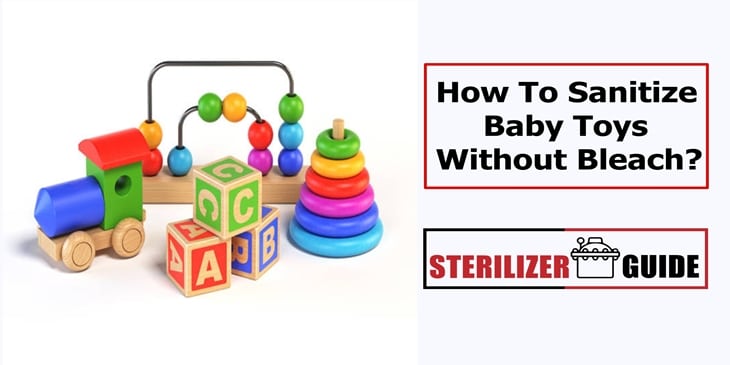Sanitizing is very important as it avoids contact to any bacteria or microorganisms. If we fail to sanitize, the risk to diarrhea and other health problems is very high especially to our kids and babies. In this article, we will learn how to sanitize our baby toys in different ways.
How To Sanitize Baby Toys Without Bleach?
We all know bleach to be a popular substance for cleaning and whitening that it’s become a household MUST. The past year’s sanitation concerns made people particularly reliant on bleach, but when it comes to cleaning your baby’s toys, there are safer and natural methods worth trying.
Bleach and Sanitizing
Before we proceed with the list, there are a few concerns worth addressing.
- Why not bleach?
- What does it mean to “sanitize” something?
The Effects of Bleach
Bleach is a corrosive substance made of Chlorine. This chemical element can be in different forms, but the bleach we use is usually in liquid form. There are two reasons why it’s harmful:
- Health reasons – When you are exposed to bleach fumes, it causes health issues. It can also easily burn human tissue and may cause poisoning when ingested. Something used for chemical warfare in WW1 doesn’t seem like something you should have in abundance in your home.
- Environmental reasons – When factories use this substance, they release toxins into the air. And when bleach is mixed with water, it may take years to dissolve the resulting harmful toxins.
Cleaning, Disinfecting, and Sanitizing
These three terms are all different. Whether it’s the rich layers or the technicalities of the English language, an understanding of these terminologies is key to knowing the alternatives of bleach.
- Cleaning – According to the CDC, cleaning physically removes germs, impurities and dirt from objects and surfaces. It is a “removal,” thereby decreasing the risk of infections. This is usually done with soap and water.
- Disinfecting – According to the CDC, disinfecting kills germs, and the surface doesn’t have to appear clean.
- Sanitizing – According to the CDC, sanitizing lowers the germ number to a safe and acceptable level through cleaning and disinfecting.
- Sterilizing – This is the destruction of all viable microorganisms by some or all three above, usually through a rigid physical and chemical process.
7 Natural Ways To Sanitize Your Baby’s Toys
Now that we have those terms out of the way let’s look at some of the natural methods for sanitizing your baby’s toys.
Use The Dishwasher
Some baby toys are labeled dishwasher safe. The hot water, steam, and soap in the dishwasher will be able to clean your baby’s toys thoroughly.
Note: Some guidelines state that 180 degrees F is the recommended temperature for sanitizing.
Hand or Machine Wash
Plush toys are safe to wash in a machine as long as you place them in a laundry bag. These should be cleaned regularly since most kids sleep with these kinds of toys.
Hot Sudsy Water
If you want to sterilize teething toys, one of the best things to do is place them in boiling water. Some even go as far as soaking it in distilled white vinegar and hot water for 15 minutes before a final cold rinse.
Vinegar Spray Bottle Mix
Wooden toys should not be immersed in water since they may potentially gather mold. You can make a spray bottle formula instead with equal parts of white vinegar and water. Spray it on the object’s surface and wipe it down with a clean cloth.
Food-Grade Wipes
Disinfectant wipes are not recommended for use around children, but there is a safer alternative in food-grade wipes. You can also use this as a 2nd step after you sterilize teething toys or use it for pacifiers. Some stores also sell specific pacifier wipes for this purpose.
UV Light
UV light is all the rage nowadays, but it should be used in conjunction with cleaning or disinfecting. It is effective against several bacteria and viruses like the flu.
Alternative Bleach Substances
Now that we want to get rid of bleach completely, here are some alternatives to consider:
- Citric juices like lemon
- Essential oils like lemon and tea tree oil
- Castile soap
- Vinegar
- Baking soda
Final Words
As more and more people focus on health, the shift to natural and safer methods is becoming increasingly popular. Now that we know safer alternatives to bleach, cleaning our kids’ toys will be a breeze—both to ourselves and the environment.

